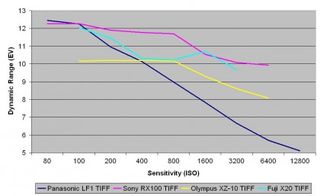Why you can trust TechRadar
We shoot a specially designed chart in carefully controlled conditions and the resulting images are analysed using DXO Analyzer software to generate the data to produce the graphs below.
A high signal to noise ratio (SNR) indicates a cleaner and better quality image.
For more more details on how to interpret our test data, check out our full explanation of our noise and dynamic range tests.
Here we compare the Panasonic LF1 with the Sony RX100, Olympus XZ-10 and Fuji X20. The Panasonic LF1 has the greatest sensitivity range of all the cameras.
JPEG signal to noise ratio

These results show that the Panasonic LF1's JPEG files have a stronger signal to noise ratio than those from the Olympus XZ-10 at ISO 800 and ISO 400-1600, while at ISO 100-200 the images from both cameras contain similar ratios, and at ISO 3200-6400 the Olympus's JPEGs beat the Panasonic's. The Panasonic's JPEGs contain weaker signal to noise ratios than JPEGs from the Sony RX100 at every sensitivity except ISO 100, and have weaker ratios than the Fuji X20's JPEGs at every sensitivity except ISO 400.
Raw signal to noise ratio

Here we see that the Panasonic LF1's TIFF images (after conversion from raw) contain greater signal to noise ratios than TIFFs from the Fuji X20 at ISO 100-800, but after that the Fuji's images are stronger. The Panasonic's TIFFs show stronger signal to noise ratios than those from the Olympus XZ-10 at ISO 100-200, but at higher sensitivities the Olympus is stronger. The Sony RX100's TIFFs have stronger signal to noise ratios than the Panasonic's at every sensitivity setting.
JPEG dynamic range

The Panasonic LF1's JPEG results for dynamic range are better, beating JPEGs from the Olympus XZ-10at every sensitivity except ISO 6400, and beating the Sony RX100's JPEGs at ISO 80-800, before falling behind at ISO 1600-6400. The Panasonic's JPEGs contain greater dynamic range than the Fuji X20's at ISO 100-400, but the Fuji's images are stronger at ISO 800-12800.
Raw dynamic range

As we can see from this chart, the Panasonic LF1's TIFF images (after conversion from raw) contain comparatively less impressive dynamic range than its JPEGs did, with levels declining steeply at mid to high sensitivity settings, falling a long way behind the other cameras towards the top of the range. The Panasonic's TIFFs are beaten by TIFFs from the Sony RX100 at every sensitivity except ISO 80 and 100, and bettered by the Fuji X20's TIFFs at every sensitivity except ISO 100. The Panasonic's TIFFs show greater dynamic range than the Olympus XZ-10's at ISO 100-400, but the Olympus's images are stronger at ISO 800-6400.
Current page: Noise and dynamic range
Prev Page Image quality and resolution Next Page Sample imagesAmy has been writing about cameras, photography and associated tech since 2009. Amy was once part of the photography testing team for Future Publishing working across TechRadar, Digital Camera, PhotoPlus, N Photo and Photography Week. For her photography, she has won awards and has been exhibited. She often partakes in unusual projects - including one intense year where she used a different camera every single day. Amy is currently the Features Editor at Amateur Photographer magazine, and in her increasingly little spare time works across a number of high-profile publications including Wired, Stuff, Digital Camera World, Expert Reviews, and just a little off-tangent, PetsRadar.


